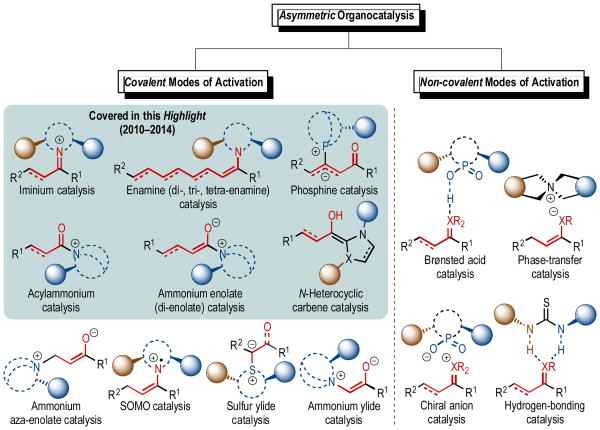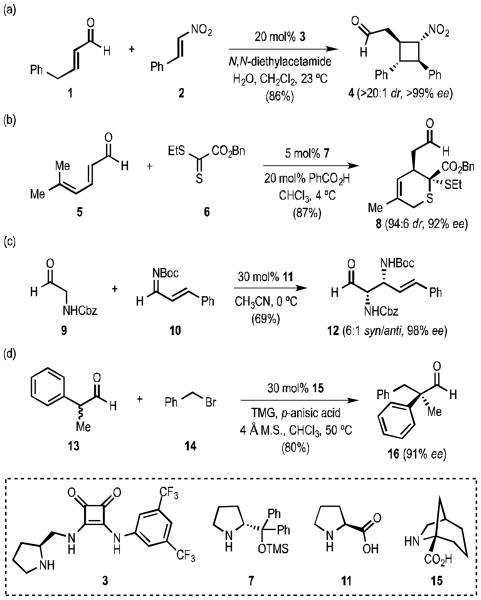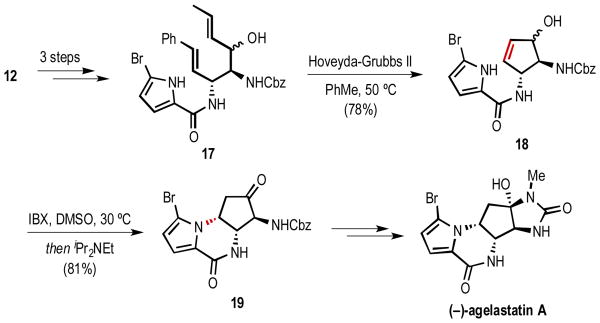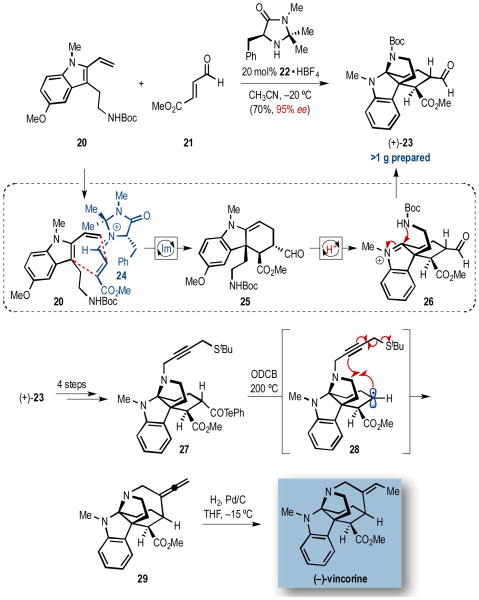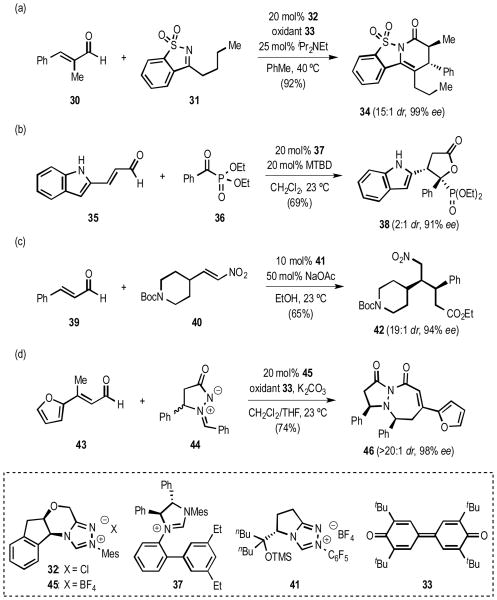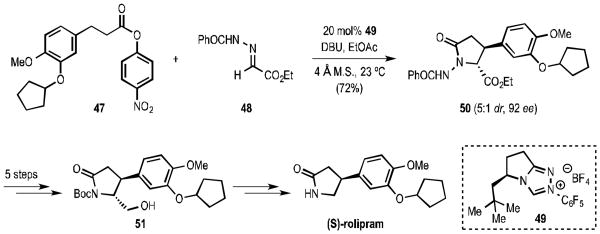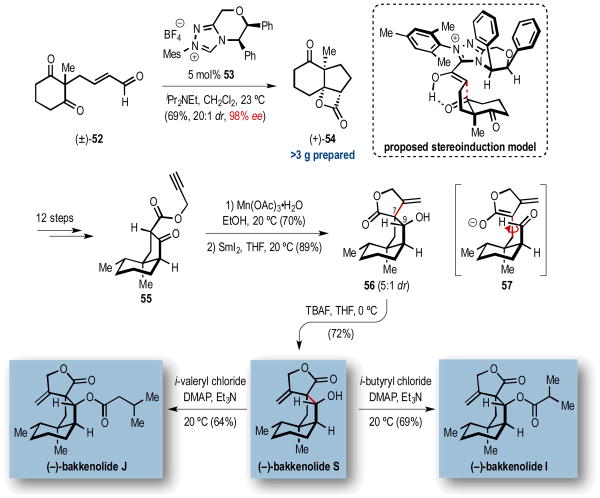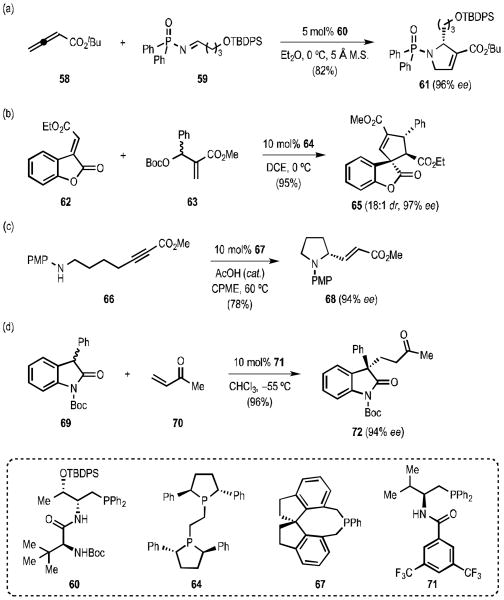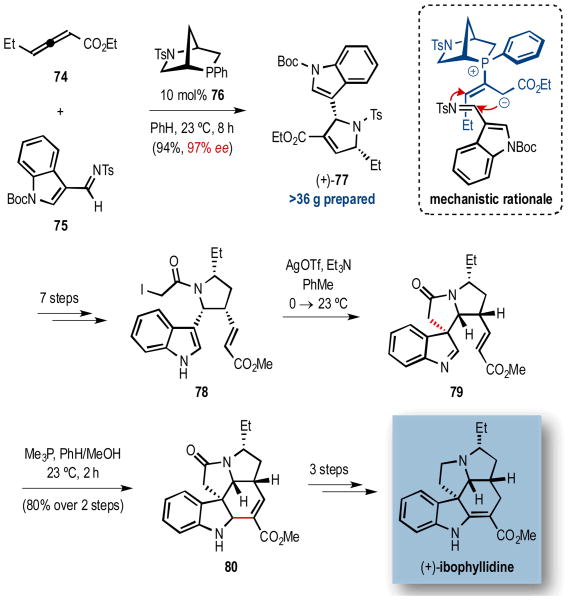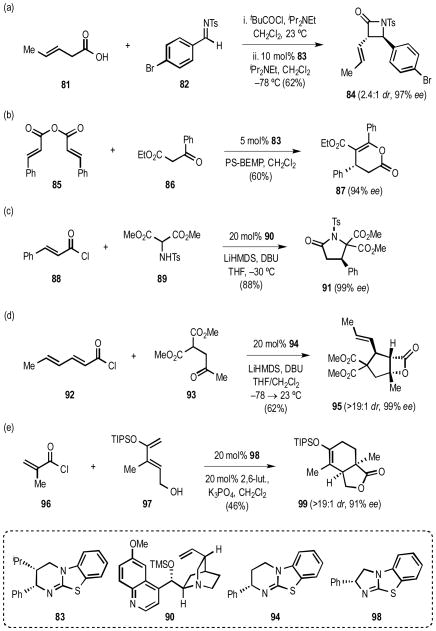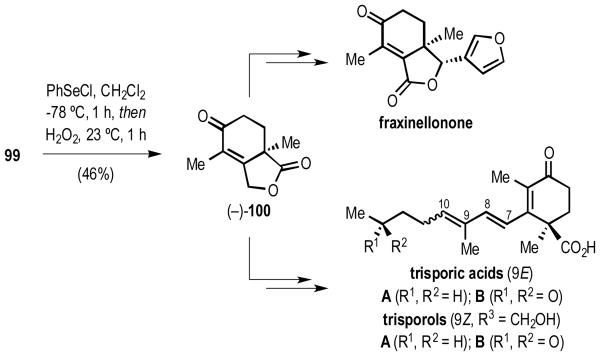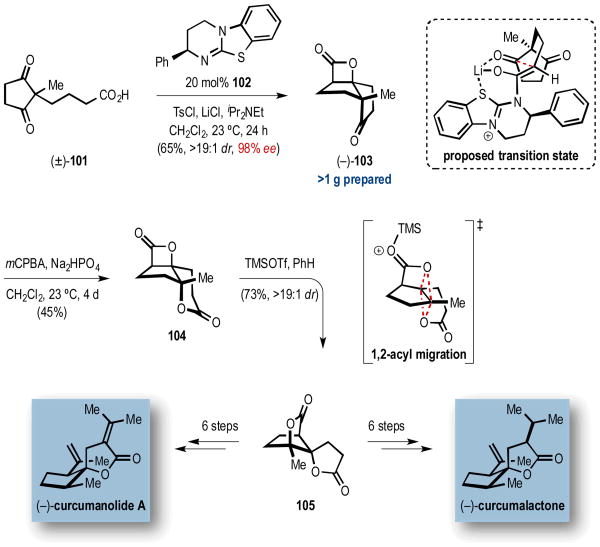Abstract
Following the turn of the millennium, the role of asymmetric covalent organocatalysis has developed into a scalable, synthetic paradigm galvanizing the synthetic community toward utilization of these methods toward more practical, metal-free syntheses of natural products. A myriad of reports on asymmetric organocatalytic modes of substrate activation relying on small, exclusively organic molecules are delineating what has now become the multifaceted field of organocatalysis. In covalent catalysis, the catalyst and substrate combine to first form a covalent, activated intermediate that enters the catalytic cycle. Following asymmetric bond formation, the chiral catalyst is recycled through hydrolysis or displacement by a pendant group on the newly formed product. Amine- and phosphine-based organocatalysts are the most common examples that have led to a vast array of reaction types. This Highlight provides a brief overview of covalent modes of organocatalysis and applications of scalable versions of these methods applied to the total synthesis of natural products including examples from our own laboratory.
1 Introduction
1.1 A Brief Historical Perspective
“I will therefore call it the ‘catalytic force’ and I will call ‘catalysis’ the decomposition of bodies by this force, in the same way that we call by ‘analysis’ the decomposition of bodies by chemical affinity.”
These famous observations by the Swedish chemist Jöns Jakob Berzelius of the University of Stockholm in 1835 sparked a new era of catalysis.1a The first organocatalytic transformation was reported in 1860 by Justus von Liebig in conversion of cyanogen to oxamide in the presence of aqueous acetaldehyde.1b The historic roots of the first asymmetric organocatalytic reaction date back to 1912, when two German chemists Bredig and Fiske reported that addition of hydrogen cyanide to benzaldehyde catalyzed by the cinchona alkaloids yields cyanohydrins in ∼10% ee.1c The use of amino acids as catalysts for aldol and condensation reactions of acetaldehyde was first documented in 1931 by Fischer and Marschall.1d In 1936, Kuhn1e found that ammonium carboxylates of optically active amines effectively catalyze the aldol reaction. The analogies in the catalytic action of enzymes and organic substances were recognized as early as 1928 by the German chemist Wolfgang Langenbeck.1f In 1949, Langenbeck revealed the conceptual difference between covalent and non-covalent catalysis, and coined the term “organic catalysis”.1g Pracejus reported the first enantioselective synthesis of esters in 1960 from phenyl methyl ketene and methanol using 1 mol% O-acetylquinine as catalyst in a quite remarkable 93% yield and 74% ee.1h,1i In 1971, the discovery of L-proline as catalyst for the intramolecular asymmetric aldol cyclodehydration was exemplified in the Hajos-Parrish-Eder-Sauer-Wiechert reaction.1j,1k Surprisingly, the viability of small organic molecules as organocatalysts in asymmetric reactions remained subcritical and over the next few decades, the area of asymmetric organocatalysis was heavily overlooked with a paucity of isolated reports.2 However in 2000, two pioneering reports by List, Lerner, Barbas3 and MacMillan4 reignited the modern age of organocatalysis triggering the “gold rush” in the last decade. MacMillan coined the term “organocatalysis” which is defined as the acceleration of a chemical transformation through addition of a substochiometric amount of an organic compound which does not contain a metal atom.4 The operational simplicity, robustness, low-cost, availability, chemical efficiency and non-toxicity render organocatalysis advantageous over metal and enzyme catalysis. Organocatalysis remains a vital pillar and popular strand of contemporary asymmetric catalysis research and is now well established in academia and industrial sectors. A myriad of excellent reviews have permeated the chemical community since 2010 in this highly topical field covering many discrete areas of organocatalysis.5 Regrettably, it is impossible to report every contribution to this rapidly growing field; therefore, a cross-section of the most recent developments in asymmetric covalent organocatalysis is described in this Highlight to provide a flavour of the exciting advances in this area and specifically their growing impact in scalable natural product synthesis.
1.2 Classification of Asymmetric Modes of Activation in Organocatalysis
The classification of asymmetric modes of activation in organocatalytic reactions is challenging. A general distinction can be made between organocatalytic processes that form covalent intermediates between catalyst and substrate and processes that rely on non-covalent interactions (Scheme 1). Further differentiation within each category can be made on the basis of the mode of substrate activation: highest occupied molecular orbital (HOMO) activation (e.g., enamine, Nheterocyclic carbene catalysis, etc.) or lowest unoccupied molecular orbital (LUMO) activation (e.g., iminium, acylammonium, etc.). It should be noted that a single organocatalyst can promote reactions by several modes of activation and thus can be classified a multifunctional catalyst.6
Scheme 1.
Classification of Asymmetric Modes of Activation in Organocatalysis.
An iminium activation mode exploits the reversible condensation of a chiral secondary or primary amine catalyst (e.g., L-proline, MacMillan's imidazolidinones, cinchona-derived primary amines, etc.) with an α,β-unsaturated aldehyde or ketone to form an iminium ion intermediate. This system effectively lowers the LUMO energy of the π-system and thus enhances its reactivity toward nucleophiles. This strategy has been successfully employed in various types of asymmetric transformations.7
In the case of saturated carbonyl systems, the LUMO energy lowering induced by the formation of an iminium ion intermediate increases the acidity of the α-proton, enabling facile deprotonation and leads to the generation of the enamine. The resultant enolate, with an effectively elevated HOMO energy, augments its reactivity toward electrophiles. This activation mode has led to the development of a vast number of asymmetric α-functionalizations of aldehydes and ketones with carbon- and heteroatom-based electrophiles.8 This concept has been extended to unsaturated carbonyl systems resulting in the discovery of dienamine,9 trienamine,10 and more recently tetraenamine11 activation modes.
In phosphine catalysis, a conjugate addition to an activated carbon-carbon double or triple bond by a chiral tertiary phosphine organocatalyst forms a β-phosphonium enolate, β-phosphonium dienolate, or vinyl phosphonium ylide as reactive intermediates. These zwitterionic species react with a broad array of nucleophiles (LUMO activation mode) and electrophiles (HOMO activation mode) to generate diverse carbo- and heterocyclic molecular architectures.12
Acylammonium catalysis is initiated by the nucleophilic attack of a chiral tertiary amine catalyst with an activated carboxylic acid derivative (e.g. acid halide, anhydride) to form an acylammonium ion intermediate. This activation mode effectively lowers the LUMO energy of the carbonyl system thus enhancing its reactivity toward nucleophiles. Several acyl-transfer organocatalysts have been developed for asymmetric acylammonium-catalyzed transformations,13 including transesterifications, kinetic resolutions, desymmetrizations, and Steglich rearrangements. Organocatalysts utilized include Fu's chiral ferrocenyl PPY catalyst,14 Vedejs' TADMAP catalyst,15 Okamoto's annulated benzothiazolylidenamine catalysts16 and Birman's dihydroimidazole CF3-PIP17 and isothiourea-based BTM18 and HBTM19 catalysts. Furthermore, this activation concept has recently been extended to unsaturated carbonyl systems prompting a diverse array of previously undisclosed complexity-generating organocascades.20
In ammonium enolate catalysis, the nucleophilic enolate equivalent (HOMO activation mode) is generated either by addition of a chiral tertiary amine catalyst to a ketene or via direct α-deprotonation of an acylammonium species. This activation mode has led to the development of numerous asymmetric α-functionalizations with carbon- and heteroatom-based electrophiles21a and prompted a spate of elegant, scalable syntheses.21b,c Further exploration of this activation concept unveiled yet another reactive intermediate, zwitterionic ammonium dienolate, generated in situ by a direct γ-deprotonation of unsaturated acylammonium ions enabling a variety of asymmetric annulations.22
In N-heterocyclic carbene (NHC) catalysis, the nucleophilic attack of the carbene catalyst (e.g., thiazolium, triazolium salts) on the carbonyl carbon (typically aldehydes) forms the initial adduct that leads to the Breslow intermediate through an external base deprotonation of the carbene-aldehyde adduct. This acyl anion equivalent can then react with different electrophiles, including another carbonyl compound as in the benzoin reaction, with Michael acceptors in the Stetter reaction, with activated or unactivated double and triple bonds without electron-withdrawing groups, or with alkyl halides. This unique mode of HOMO activation takes advantage of the inversion of classical reactivity (umpolung) and offers a broad range of unconventional transformations.23
2 Iminium/Enamine Catalysis
2.1 Recent Developments in the Iminium/Enamine Catalysis: Synopses of Examples including Formal Syntheses
Jørgensen9a recently introduced a new dual activation mode of α,β-unsaturated aldehydes 1, via dienamine formation, and activation of nitro-olefins 2, via hydrogen-bonding, affording fully substituted cyclobutanes 4 by an organocatalytic formal [2 + 2]-cycloaddition catalyzed by a computationally designed catalyst 3 (Scheme 2a). In other work, Jørgensen10c utilized trienamine-activated dienes, generated in situ from α,β,γ,δ,-dienyl aldehydes 5 and chiral aminocatalyst 7, in thio-Diels-Alder reactions with thiocarbonyls 6 to access highly enantioenriched dihydrothiopyrans 8 (Scheme 2b). In 2012, Maruoka and co-workers24 developed the first diastereo- and enantioselective direct Mannich reaction (Scheme 2c) of N-protected α-aminoacetaldehydes 9 with N-protected imines 10 catalyzed by L-proline (11). This organocatalytic process delivers optically active vicinal diamines 12, motifs present in a number of natural products and useful chiral catalysts. More recently, List25 disclosed the first aminocatalyzed α-alkylation of racemic α-branched aldehydes 13 with benzyl bromide (14) as alkylating agent via enamine catalysis (Scheme 2d). Using a sterically demanding proline-derived catalyst 15, enantiomerically enriched α-alkylated aldehydes with quaternary stereogenic centers were obtained in good yields and high enantioselectivities.
Scheme 2.
Recent examples of asymmetric iminium/enamine catalysis.
Maruoka successfully demonstrated the synthetic utility of the developed Mannich reaction in the formal synthesis of (−)-agelastatin A, a potent antitumor marine alkaloid (Scheme 3). Mannich product, diamine 12, was converted to diene 17 in 3 steps. Treatment of 17 with Hoveyda-Grubbs second-generation catalyst afforded cyclopentene 18, which was converted in one pot to cyclopentanone 19, an intermediate previously used in the synthesis of (−)-agelastatin A.
Scheme 3.
Application of diamine 12 towards the formal synthesis of (−)-agelastatin A.
2.2 MacMillan's Total Synthesis of (−)-Vincorine
In 2013, Horning and MacMillan26a reported a concise, enantioselective total synthesis of (−)-vincorine, an akuammiline alkaloid containing a tetracyclic cage-like core with a strained seven-membered azepanyl ring system. Various members of this alkaloid family are known to exhibit anti-cancer activity and glycine receptor antagonism. A prominent feature of the synthesis is a scalable, organocatalytic DielsAlder/iminium cyclization cascade, the general synthetic strategy for representative polycyclic indole alkaloids,26b initiated by a highly enantioselective endo Diels-Alder reaction between diene 20 and in situ generated α,β-unsaturated iminium dienophile 24 delivering cycloadduct 25 (Scheme 4). Subsequent, Brønsted acid-mediated conversion of 25 to iminium 26 prompted intramolecular 5-exo cyclization by the pendant carbamate group to generate the tetracyclic adduct 23, on gram scale (>1 g), bearing three of four stereocenters found in vincorine including the all-carbon quaternary center. Final seven-membered azepanyl ring annulation was accomplished by 7-exo-dig radical cyclization initiated with an unusual acyl telluride precursor 27 under thermal conditions providing allene 29. The authors postulate C–Te bond homolysis and loss of carbon monoxide to generate alkyl radical 28. Selective terminal hydrogenation from the less hindered face of the allene functionality furnished (−)-vincorine as a single olefin isomer in nine total steps and 9% overall yield.
Scheme 4.
MacMillan's total synthesis of (−)-vincorine.
3 N-Heterocyclic Carbene Catalysis
3.1 Recent Developments in N-Heterocyclic Carbene Catalysis: Synopses of Examples including Formal Syntheses
In 2012, Bode27a disclosed a new class of NHC-catalyzed annulations of trisubstituted α,β-unsaturated aldehydes 30 and cyclic N-sulfonylimines 31 (Scheme 5a) operating through the catalytic generation of α,β-unsaturated acyl azoliums in the presence of catalyst 32 and oxidant 33. Scheidt and coworkers27b developed a highly selective synthesis of γ-butyrolactones through a formal [3+2] annulation (Scheme 5b) of α,β-unsaturated aldehydes 35 and acyl phosphonates 36 catalyzed by a computationally designed, C1-symmetric biaryl-saturated imidazolium catalysts 37. Rovis27c recently developed a novel chiral N-heterocyclic carbene catalyst 41 that favors a homoenolate pathway over the established acyl anion (Stetter) pathway. This enabled a novel coupling between α,β-unsaturated aldehydes 39 and nitroalkenes 40 to access a diverse array of syn-δ-nitroesters 42 (Scheme 5c). More recently, Chi and co-workers27d disclosed the first Nheterocyclic carbene catalyzed [3+4] cycloaddition of α,β-unsaturated aldehydes 43 and azomethine imines 44 to generate dinitrogen-fused seven-membered heterocycles 46 (Scheme 5d). In this process, NHC catalyst 45 also enables a highly effective kinetic resolution of racemic azomethine imines 44.
Scheme 5.
Recent examples of asymmetric N-heterocyclic carbene catalysis.
Activation of the otherwise inert β-sp3 carbon of saturated esters as nucleophiles has recently been achieved by Chi and co-workers28 utilizing NHC catalyst 49. This methodology delivers a diverse set of optically active substrates including cyclopentenes, γ-butyrolactones and γ-lactams (e.g. 50, Scheme 6). Chi then established the utility of this methodology employing saturated ester 47 and hydrazone 48 to provide a concise, formal asymmetric synthesis of (S)-rolipram, a potent phosphodiesterase inhibitor (Scheme 6). The synthesis of 51, a key intermediate previously employed in the synthesis of (S)-rolipram, was achieved in 5 steps from γ-lactam 50.
Scheme 6.
Application of γ-lactam 50 towards the formal synthesis of (S)-rolipram.
3.2 Scheidt's Total Syntheses of (−)-Bakkenolides I, J, and S
Scheidt has recently described the utility of the tricyclic β-lactone (+)-54, obtained by desymmetrization through an aldollactonization reaction of readily accessible 1,3-diketone 52 catalyzed by N-heterocyclic carbene 53,29a as a key intermediate in the enantioselective total syntheses of (−)-bakkenolides I, J, and S (Scheme 7).29b The tricyclic β-lactone (+)-54 was prepared on gram scale (>3 g) in 69% yield with 98% ee as a single diastereomer.
Scheme 7.
Scheidt's total syntheses of (−)-bakkenolides I, J, and S.
The stereochemical outcome of the reaction was rationalized through the transition state model depicted in Scheme 7. A 12-step elaboration of the fused 6,5-bicyclic ring system (+)-54, led to the β-keto propargyl ester 55 and set the stage for the formation of the key γ-spirobutyrolactone. Thus, in the presence of Mn(OAc)3, the β-keto propargyl ester 55 cyclized, forming the γ-spirobutyrolactone 56 as a 5:1 mixture of diastereomers, following reduction of the resulting ketone using SmI2. However, this route produced the undesired epimer at the C7 position. Fortunately, exposure of 56 to TBAF promoted an intriguing retro-aldol/aldol sequence (via formation of transient aldehyde 57) to afford the desired diastereomer, (−)-bakkenolide S. The authors hypothesized that this thermodynamically favoured process is driven by hydrogen bonding between the C9 secondary alcohol and the γ-spirobutyrolactone carbonyl oxygen. Finally, conversion to (−)-bakkenolides I and J was accomplished by direct acylation of (−)-bakkenolide S with isobutyryl and isovaleryl chlorides, respectively. These natural products possess a wide spectrum of biological activity including antifeedant effects, platelet aggregation inhibition, and potent inhibitory activity against a variety of tumor cell lines.
4 Phosphine Catalysis
4.1 Recent Developments in Phosphine Catalysis: Synopses of Examples including Formal Syntheses
The Lu group30a broadened the potential of chiral peptide-based phosphines 60 for catalysis of allene-alkylimine [3+2] annulations (Scheme 8a) leading to synthetically valuable optically pure five-membered N-heterocycles (e.g., 61). Recently, Barbas30b utilized C2-symmetric phospholane 64 to promote an expeditious assembly of complex polysubstituted spirocyclopentenebenzo-furanones 65 (Scheme 8b) consisting of three contiguous stereocenters, including an all-carbon quaternary carbon. In their recent studies, Fu and coworkers30c reported the first examples of intra- and intermolecular γ-umpolung additions of nitrogen nucleophiles to allenoates and alkynoates (Scheme 8c) with spirophosphepine 67 found to be the optimal catalyst. More recently, Lu30d disclosed the first asymmetric phosphine-catalyzed Michael addition (Scheme 8d) mediated by a chiral phosphine 71 that was presumed to promote additional catalyst-substrate interactions through hydrogen bonding.
Scheme 8.
Recent examples of asymmetric phosphine catalysis.
Lu and co-workers demonstrated the utility of the asymmetric allene-alkylimine [3+2] methodology by a concise formal asymmetric synthesis of (+)-trachelanthamidine (Scheme 9). The synthesis of 73, a key intermediate previously employed in the synthesis of (+)-trachelanthamidine, a pyrrolizidine alkaloid possessing a wide range of pharmacologically relevant activities, was secured from dihydropyrroline 61 following removal of protecting groups.
Scheme 9.
Application of dihydropyrroline 61 towards the formal synthesis of (+)-trachelanthamidine.
4.2 Kwon's Total Synthesis of (+)-Ibophyllidine
Recently, Andrews and Kwon reported the first example of asymmetric phosphine-catalyzed [3+2] annulation employed in the total synthesis of (+)-ibophyllidine31 (Scheme 10), a member of the terpene indole alkaloids possessing intriguing biological activities. The practical procedure allowed the preparation of the optically pure pyrroline (+)-77 as a single syn-diastereomer on 30 g scale in excellent yield with high enantiocontrol employing the readily accessible allenoate 74 and imine 75 with the chiral [2.2.1] bicyclic phosphine catalyst 76. Following a 7-step elaboration of the pyrroline (+)-77 to the cyclization precursor 78, AgOTf-mediated intramolecular spiroalkylation delivered the desired indolenine 79. The final six-membered E-ring of (+)-ibophyllidine was formed via an intramolecular aza-Morita-Baylis-Hillman reaction, again through phosphine catalysis, yielding the desired pentacyclic framework 80 in 80% yield over two steps. Overall, the first enantioselective synthesis of (+)-ibophyllidine was accomplished in 15 steps and 13% overall yield through enantioselective phosphine-based catalysis.
Scheme 10.
Kwon's total synthesis of (+)-ibophyllidine.
5 Acylammonium/Ammonium Enolate Catalysis
5.1 Recent Developments in Acylammonium/ Ammonium Enolate Catalysis: Synopses of Examples including Formal Syntheses
The Smith22b group recently utilized in situ activated β,γ-unsaturated alkenoic acids 81 through mixed anhydride formation, as ammonium dienolate precursors in an enantioselective formal [2+2] cycloaddition with N-tosyl aldimines 82 promoted by a chiral isothiourea HBTM-2.1 (83) catalyst (Scheme 11a). Building on early work by Fu, who demonstrated the potential of acid fluorides and unsaturated aclylammonium catalysis for a tandem allylsilane/ene reaction,20a Smith recently demonstrated the utility of mixed anhydrides and unsaturated acylammoniums for the enantioselective synthesis of enol lactones 87 (Scheme 11b).20b In our own studies in this area, the full potential of the latent, triply reactive, α,β-unsaturated acylammonium catalysis was realized employing acid chlorides (e.g., 88, 92) and carboxylic acids in a rapid assembly of complex cyclopentanes20d 95 (Scheme 11d) and in a further extension, N-heterocycles20c 91 (Scheme 11c). Furthermore, we very recently demonstrated the utility of these chiral α,β-unsaturated acylammonium salts as competent chiral dienophiles in a Diels-Alder-lactonization (DAL) organocascade20e (Scheme 11e).
Scheme 11.
Recent examples of asymmetric acylammonium/ammonium enolate catalysis.
The utility of the DAL methodology was validated through a short, enantioselective synthesis of cyclohexenone (−)-100 from cycloadduct 99. Bicyclic lactone 100 was previously employed in racemic form for the synthesis of (±)-fraxinellonone, a degraded limonoid that displays moderate antifeedant and ichthyotoxicity activity, in addition to (±)-trisporic acid and (±)-trisporols, naturally occurring fungal pheromones derived from β-carotene (Scheme 12).
Scheme 12.
Application of bicyclic γ-lactone 99 towards the formal syntheses of fraxinellonone, trisporic acids, and trisporols.
5.2 Romo's Total Synthesis of (−)-Curcumanolide A and (−)-Curcumalactone
A recent example of scalable, ammonium enolate catalysis can be found in the asymmetric, divergent route to the spirocyclic sesquiterpene natural products (−)-curcumanolide A and (−)-curcumalactone from common spirocycle 105 (Scheme 13).32a These spirolactone-containing sesquiterpenoids are present in the crude drug Zedoary, have been used as remedies for cervical cancer, and were reported to exhibit anti-inflammatory activity. The synthesis of these natural products demonstrated the gram-scale utility of the organocatalytic, asymmetric nucleophile-catalyzed aldol-lactonization (NCAL) desymmetrization process32b of dione acid (±)-101 leading to a tricyclic β-lactone (−)-103 via a proposed bicyclic boat-like transition-state arrangement (as depicted in Scheme 13). Furthermore, the ability to perform a Baeyer-Villiger oxidation in the presence of a β-lactone (−)-103 led to the ring-expanded δ-lactone 104 and set the stage for a key dyotropic rearrangement. This rare dyotropic process, involving a fused bis-lactone 104 possessing both β- and δ-lactone moieties, enabled rapid access to the core structure 105 of curcumanolide A and curcumalactone. Our current mechanistic understanding of the transition state for this transformation, based on computational studies by the Tantillo group, involves a nearly concerted, stereospecific, “double SN2” 1,2-bis-acyl migration process (as shown in Scheme 13) delivering the bridged, spiro-γ-butyrolactone 105.32c The described enantioselective total synthesis of curcumanolide A and curcumalactone was accomplished in 11 and 12 steps, respectively, and employed scalable, ammonium enolate organocatalysis.
Scheme 13.
Romo's total synthesis of (−)-curcumanolide A and (−)-curcumalactone.
Although racemic, a recent application of the NCAL methodology by Weinreb deserves mention given that it was performed on >2 g scale and utilized as a key step for constructing the cis-2-azadecalin found in the indole alkaloids, (±)-alstilobanine A and E, and (±)-angustilodine.33
6 Conclusions and Perspective
In the past decade, the field of asymmetric covalent organocatalysis has seen tremendous progress. This Highlight has briefly illustrated the power of these organocatalytic reactions, which have become a prevalent and highly efficient tool in organic chemistry. The discovery and implementation of new reactivities and organocatalysts led to a considerable surge in reaction efficiency and selectivity. Indeed, the discovery of novel activation modes for substrates employing secondary amine catalysis, N-heterocyclic carbine catalysis, phosphine catalysis, and tertiary amine catalysis has enabled rapid construction of molecular complexity with excellent levels of stereocontrol and simple operational procedures employing non-heavy metal catalysts. These advances have led to many successful and imaginative applications of asymmetric covalent organocatalysis in the field of scalable natural product synthesis. Despite significant innovations in this highly topical area, there still remain many challenges and opportunities ahead. Certainly, the relatively high catalyst loading (e.g., 10 and 20 mol%) in many cases leaves room for future improvement. Furthermore, the discovery of novel modes of substrate activation, especially of commodity chemicals, will drive further advances in the area of organocatalysis enabling unusual disconnections and more practical procedures. Based on the diversity of recently developed activation modes involving covalent organocatalysis, numerous organocascade sequences can be envisaged and will undoubtedly be applied to more ambitious synthetic targets. Given these advances, we further anticipate powerful strategies for the scalable synthesis of biologically relevant molecules including bioactive natural products and pharmaceuticals, providing invaluable tools for continued advances in biology. However, realizing these goals in earnest, necessitates not only the discovery but also invention of new modes of reactivity, that either exposes or amplifies both the innate and sometimes hidden reactivity of organic substrates, which in turn contributes to further developments in chemical synthesis logic. This principle finds its full expression in the words of the epitome of the artist-scientist, Leonardo da Vinci:
“Where nature finishes producing its own species, man begins, using natural things and with the help of this nature, to create an infinity of species.”
Acknowledgments
We gratefully acknowledge the National Science Foundation (CHE-1112397), the Robert A. Welch Foundation (A-1280), and partial support from NIH (R37 GM069874) for generous support of the Romo Group's contributions to this area of research.
Biographies

Mikail E. Abbasov was born in 1980 in Baku, Azerbaijan and received a B.S. in Biochemistry from West Texas A&M University in 2004. After having conducted his M.S. in Chemical Physics at the Killgore Research Center (WTAMU) with Professor Gene O. Carlisle in 2008, he joined the research group of Professor Daniel Romo at Texas A&M University where he is currently pursuing a Ph.D. degree in Organic Chemistry. His research focuses on the synthesis and derivatization of polyketide and alkaloid natural products and the development of organocatalytic cascades.

Daniel Romo received his B.A. in Chemistry/Biology from Texas A&M University and a Ph.D. in Chemistry from Colorado State University as a NSF Minority Graduate Fellow under the tutelage of the late Professor Albert I. Meyers. Following postdoctoral studies at Harvard as an American Cancer Society Fellow with Professor Stuart L. Schreiber, he began his independent career at Texas A&M in 1993 and is currently Gradipore Professor of Chemistry and Director of the Natural Products LINCHPIN Laboratory. Research interests in the Romo Group are at the interface of chemistry and biology focused on total synthesis, biosynthesis, and cellular mechanism of action studies of bioactive natural products, the asymmetric synthesis and application of β-lactones as intermediates for organic synthesis, cellular probes, and drug candidates, and synthetic methodology focused on new organocascade processes.
References
- 1.Lindstrom B, Pettersson LJ. Cattech. 2003;7:130–138.Liebig J. Ann Chem Pharm. 1860;13:246–247.Bredig G, Fiske PS. Biochem Z. 1912;46:7–23.Fischer FG, Marschall A. Ber Dtsch Chem Ges. 1931;64:2825–2827.Kuhn R, Badstubner W, Grundmann C. Ber Dtsch Chem Ges. 1936;69:98–107.Langenbeck W. Angew Chem. 1928;41:740–745. (g) W. Langenbeck, 2nd ed., Springer, Berlin, 1949; Pracejus H. Liebigs Ann Chem. 1960;634:9–22.Pracejus H. Liebigs Ann Chem. 1960;634:23–29.Eder U, Sauer G, Weichert R. Angew Chem Int Ed. 1971;10:496–497.Hajos ZG, Parrish DR. J Org Chem. 1974;39:1615–1621.
- 2.(a) Ooi T, Kameda M, Maruoka K. J Am Chem Soc. 1999;121:6519–6520. [Google Scholar]; (b) Corey EJ, Grogan MJ. Org Lett. 1999;1:157–160. doi: 10.1021/ol990623l. [DOI] [PubMed] [Google Scholar]; (c) Sigman MS, Jacobsen EN. J Am Chem Soc. 1998;120:5315–5316. [Google Scholar]; (d) Ruble JC, Latham HA, Fu GC. J Am Chem Soc. 1997;119:1492–1493. [Google Scholar]; (e) Corey EJ, Xu F, Noe MC. J Am Chem Soc. 1997;119:12414–12415. [Google Scholar]; (f) Tu Y, Wang ZX, Shi Y. J Am Chem Soc. 1996;118:9806–9807. [Google Scholar]; (g) Denmark SE, Coe DM, Pratt NE, Griedel BD. J Org Chem. 1994;59:6161–6163. doi: 10.1021/jo052202p. [DOI] [PubMed] [Google Scholar]; (h) Odonnell MJ, Bennett WD, Wu SD. J Am Chem Soc. 1989;111:2353–2355. [Google Scholar]; (i) Oku JI, Inoue S. J Chem Soc Chem Commun. 1981:229–230. [Google Scholar]; (j) Julia S, Masana J, Vega JC. Angew Chem Int Ed. 1980;19:929–931. [Google Scholar]
- 3.List B, Lerner RA, Barbas CF. J Am Chem Soc. 2000;122:2395–2396. [Google Scholar]
- 4.Ahrendt KA, Borths CJ, MacMillan DWC. J Am Chem Soc. 2000;122:4243–4244. [Google Scholar]
- 5.(a) Nakamura S. Org Biomol Chem. 2014;12:394–405. doi: 10.1039/c3ob42161a. [DOI] [PubMed] [Google Scholar]; (b) Mlynarski J, Bas S. Chem Soc Rev. 2014;43:577–587. doi: 10.1039/c3cs60202h. [DOI] [PubMed] [Google Scholar]; (c) Mahatthananchai J, Bode JW. Acc Chem Res. 2014;47:696–707. doi: 10.1021/ar400239v. [DOI] [PubMed] [Google Scholar]; (d) Zeng X. Chem Rev. 2013;113:6864–6900. doi: 10.1021/cr400082n. [DOI] [PubMed] [Google Scholar]; (e) Wei Y, Shi M. Chem Rev. 2013;113:6659–6690. doi: 10.1021/cr300192h. [DOI] [PubMed] [Google Scholar]; (f) Volla CMR, Atodiresei I, Rueping M. Chem Rev. 2013;114:2390–2431. doi: 10.1021/cr400215u. [DOI] [PubMed] [Google Scholar]; (g) Shirakawa S, Maruoka K. Angew Chem Int Ed. 2013;52:4312–4348. doi: 10.1002/anie.201206835. [DOI] [PubMed] [Google Scholar]; (h) Scheffler U, Mahrwald R. Chem Eur J. 2013;19:14346–14396. doi: 10.1002/chem.201301996. [DOI] [PubMed] [Google Scholar]; (i) Novacek J, Waser M. Eur J Org Chem. 2013:637–648. [Google Scholar]; (j) Nelson DJ, Nolan SP. Chem Soc Rev. 2013;42:6723–6753. doi: 10.1039/c3cs60146c. [DOI] [PubMed] [Google Scholar]; (k) Murai K, Fujioka H. Heterocycles. 2013;87:763–805. [Google Scholar]; (l) Masson G, Lalli C, Benohoud M, Dagousset G. Chem Soc Rev. 2013;42:902–923. doi: 10.1039/c2cs35370a. [DOI] [PubMed] [Google Scholar]; (m) Mahlau M, List B. Angew Chem Int Ed. 2013;52:518–533. doi: 10.1002/anie.201205343. [DOI] [PubMed] [Google Scholar]; (n) Kumar P, Dwivedi N. Acc Chem Res. 2013;46:289–299. doi: 10.1021/ar300135u. [DOI] [PubMed] [Google Scholar]; (o) Jiang X, Wang R. Chem Rev. 2013;113:5515–5546. doi: 10.1021/cr300436a. [DOI] [PubMed] [Google Scholar]; (p) Du Z, Shao Z. Chem Soc Rev. 2013;42:1337–1378. doi: 10.1039/c2cs35258c. [DOI] [PubMed] [Google Scholar]; (q) Aleman J, Cabrera S. Chem Soc Rev. 2013;42:774–793. doi: 10.1039/c2cs35380f. [DOI] [PubMed] [Google Scholar]; (r) Zhuo CX, Zhang W, You SL. Angew Chem Int Ed. 2012;51:12662–12686. doi: 10.1002/anie.201204822. [DOI] [PubMed] [Google Scholar]; (s) Zheng C, You SL. Chem Soc Rev. 2012;41:2498–2518. doi: 10.1039/c1cs15268h. [DOI] [PubMed] [Google Scholar]; (t) Wende RC, Schreiner PR. Green Chem. 2012;14:1821–1849. [Google Scholar]; (u) Taylor JE, Bull SD, Williams JMJ. Chem Soc Rev. 2012;41:2109–2121. doi: 10.1039/c2cs15288f. [DOI] [PubMed] [Google Scholar]; (v) Phipps RJ, Hamilton GL, Toste FD. Nat Chem. 2012;4:603–614. doi: 10.1038/nchem.1405. [DOI] [PubMed] [Google Scholar]; (w) Pellissier H. Adv Synth Catal. 2012;354:237–294. [Google Scholar]; (x) Mlynarski J, Gut B. Chem Soc Rev. 2012;41:587–596. doi: 10.1039/c1cs15144d. [DOI] [PubMed] [Google Scholar]; (y) Melchiorre P. Angew Chem Int Ed. 2012;51:9748–9770. doi: 10.1002/anie.201109036. [DOI] [PubMed] [Google Scholar]; (z) Marson CM. Chem Soc Rev. 2012;41:7712–7722. doi: 10.1039/c2cs35183h. [DOI] [PubMed] [Google Scholar]; (aa) Mahatthananchai J, Dumas AM, Bode JW. Angew Chem Int Ed. 2012;51:10954–10990. doi: 10.1002/anie.201201787. [DOI] [PubMed] [Google Scholar]; (ab) Lu LQ, Chen JR, Xiao WJ. Acc Chem Res. 2012;45:1278–1293. doi: 10.1021/ar200338s. [DOI] [PubMed] [Google Scholar]; (ac) Loh CCJ, Enders D. Chem Eur J. 2012;18:10212–10225. doi: 10.1002/chem.201200287. [DOI] [PubMed] [Google Scholar]; (ad) Liu TY, Xie M, Chen YC. Chem Soc Rev. 2012;41:4101–4112. doi: 10.1039/c2cs35017c. [DOI] [PubMed] [Google Scholar]; (ae) Giacalone F, Gruttadauria M, Agrigento P, Noto R. Chem Soc Rev. 2012;41:2406–2447. doi: 10.1039/c1cs15206h. [DOI] [PubMed] [Google Scholar]; (af) de Graaff C, Ruijter E, Orru RVA. Chem Soc Rev. 2012;41:3969–4009. doi: 10.1039/c2cs15361k. [DOI] [PubMed] [Google Scholar]; (ag) Dalpozzo R, Bartoli G, Bencivenni G. Chem Soc Rev. 2012;41:7247–7290. doi: 10.1039/c2cs35100e. [DOI] [PubMed] [Google Scholar]; (ah) Caminade AM, Ouali A, Keller M, Majoral JP. Chem Soc Rev. 2012;41:4113–4125. doi: 10.1039/c2cs35030k. [DOI] [PubMed] [Google Scholar]; (ai) Briere JF, Oudeyer S, Dalla V, Levacher V. Chem Soc Rev. 2012;41:1696–1707. doi: 10.1039/c1cs15200a. [DOI] [PubMed] [Google Scholar]; (aj) Yu J, Shi F, Gong LZ. Acc Chem Res. 2011;44:1156–1171. doi: 10.1021/ar2000343. [DOI] [PubMed] [Google Scholar]; (ak) Valero G, Companyo X, Rios R. Chem Eur J. 2011;17:2018–2037. doi: 10.1002/chem.201001546. [DOI] [PubMed] [Google Scholar]; (al) Schenker S, Zamfir A, Freund M, Tsogoeva SB. Eur J Org Chem. 2011:2209–2222. [Google Scholar]; (am) Rueping M, Nachtsheim BJ, Ieawsuwan W, Atodiresei I. Angew Chem Int Ed. 2011;50:6706–6720. doi: 10.1002/anie.201100169. [DOI] [PubMed] [Google Scholar]; (an) Rueping M, Kuenkel A, Atodiresei I. Chem Soc Rev. 2011;40:4539–4549. doi: 10.1039/c1cs15087a. [DOI] [PubMed] [Google Scholar]; (ao) Rueping M, Dufour J, Schoepke FR. Green Chem. 2011;13:1084–1105. [Google Scholar]; (ap) Piovesana S, Schietroma DMS, Bella M. Angew Chem Int Ed. 2011;50:6216–6232. doi: 10.1002/anie.201005955. [DOI] [PubMed] [Google Scholar]; (aq) Pansare SV, Paul EK. Chem Eur J. 2011;17:8770–8779. doi: 10.1002/chem.201101269. [DOI] [PubMed] [Google Scholar]; (ar) Narayanam JMR, Stephenson CRJ. Chem Soc Rev. 2011;40:102–113. doi: 10.1039/b913880n. [DOI] [PubMed] [Google Scholar]; (as) Mueller CE, Schreiner PR. Angew Chem Int Ed. 2011;50:6012–6042. doi: 10.1002/anie.201006128. [DOI] [PubMed] [Google Scholar]; (at) Moyano A, Rios R. Chem Rev. 2011;111:4703–4832. doi: 10.1021/cr100348t. [DOI] [PubMed] [Google Scholar]; (au) Diaz de Villegas MD, Galvez JA, Etayo P, Badorrey R, Lopez-Ram-de-Viu P. Chem Soc Rev. 2011;40:5564–5587. doi: 10.1039/c1cs15120g. [DOI] [PubMed] [Google Scholar]; (av) Cheong PHY, Legault CY, Um JM, Celebi-Oelcuem N, Houk KN. Chem Rev. 2011;111:5042–5137. doi: 10.1021/cr100212h. [DOI] [PMC free article] [PubMed] [Google Scholar]; (aw) Busacca CA, Fandrick DR, Song JJ, Senanayake CH. Adv Synth Catal. 2011;353:1825–1864. [Google Scholar]; (ax) Aleman J, Parra A, Jiang H, Jorgensen KA. Chem Eur J. 2011;17:6890–6899. doi: 10.1002/chem.201003694. [DOI] [PubMed] [Google Scholar]; (ay) Albrecht L, Jiang H, Jorgensen KA. Angew Chem Int Ed. 2011;50:8492–8509. doi: 10.1002/anie.201102522. [DOI] [PubMed] [Google Scholar]; (az) Weiner B, Szymanski W, Janssen DB, Minnaard AJ, Feringa BL. Chem Soc Rev. 2010;39:1656–1691. doi: 10.1039/b919599h. [DOI] [PubMed] [Google Scholar]; (ba) Wei Y, Shi M. Acc Chem Res. 2010;43:1005–1018. doi: 10.1021/ar900271g. [DOI] [PubMed] [Google Scholar]; (bb) Trost BM, Brindle CS. Chem Soc Rev. 2010;39:1600–1632. doi: 10.1039/b923537j. [DOI] [PMC free article] [PubMed] [Google Scholar]; (bc) Terrasson V, de Figueiredo RM, Campagne JM. Eur J Org Chem. 2010:2635–2655. [Google Scholar]; (bd) Nielsen M, Jacobsen CB, Holub N, Paixao MW, Jorgensen KA. Angew Chem Int Ed. 2010;49:2668–2679. doi: 10.1002/anie.200906340. [DOI] [PubMed] [Google Scholar]; (be) Moyano A, El-Hamdouni N, Atlamsani A. Chem Eur J. 2010;16:5260–5273. doi: 10.1002/chem.200903410. [DOI] [PubMed] [Google Scholar]; (bf) Marques-Lopez E, Herrera RP, Christmann M. Nat Prod Rep. 2010;27:1138–1167. doi: 10.1039/b924964h. [DOI] [PubMed] [Google Scholar]; (bg) Kristensen TE, Hansen T. Eur J Org Chem. 2010:3179–3204. [Google Scholar]; (bh) Grondal C, Jeanty M, Enders D. Nat Chem. 2010;2:167–178. doi: 10.1038/nchem.539. [DOI] [PubMed] [Google Scholar]; (bi) Bartoli G, Bencivenni G, Dalpozzo R. Chem Soc Rev. 2010;39:4449–4465. doi: 10.1039/b923063g. [DOI] [PubMed] [Google Scholar]; (bj) Albrecht L, Albrecht A, Krawczyk H, Jorgensen KA. Chem Eur J. 2010;16:28–48. doi: 10.1002/chem.200902634. [DOI] [PubMed] [Google Scholar]; (bk) Alba ANR, Companyo X, Rios R. Chem Soc Rev. 2010;39:2018–2033. doi: 10.1039/b911852g. [DOI] [PubMed] [Google Scholar]
- 6.Doyle AG, Jacobsen EN. Chem Rev. 2007;107:5713–5743. doi: 10.1021/cr068373r. [DOI] [PubMed] [Google Scholar]
- 7.(a) Lelais G, MacMillan DWC. Aldrichimica Acta. 2006;39:79–87. [Google Scholar]; (b) Erkkila A, Majander I, Pihko PM. Chem Rev. 2007;107:5416–5470. doi: 10.1021/cr068388p. [DOI] [PubMed] [Google Scholar]
- 8.(a) List B. Acc Chem Res. 2004;37:548–557. doi: 10.1021/ar0300571. [DOI] [PubMed] [Google Scholar]; (b) Mukherjee S, Yang JW, Hoffmann S, List B. Chem Rev. 2007;107:5471–5569. doi: 10.1021/cr0684016. [DOI] [PubMed] [Google Scholar]; (c) Kumar P, Dwivedi N. Acc Chem Res. 2012;46:289–299. doi: 10.1021/ar300135u. [DOI] [PubMed] [Google Scholar]; (d) Li JL, Liu TY, Chen YC. Acc Chem Res. 2012;45:1491–1500. doi: 10.1021/ar3000822. [DOI] [PubMed] [Google Scholar]
- 9.(a) Albrecht Ł, Dickmeiss G, Acosta FC, Rodríguez-Escrich C, Davis RL, Jørgensen KA. J Am Chem Soc. 2012;134:2543–2546. doi: 10.1021/ja211878x. [DOI] [PubMed] [Google Scholar]; (b) Ramachary DB, Reddy YV. Eur J Org Chem. 2012:865–887. [Google Scholar]
- 10.(a) Albrecht Ł, Acosta FC, Fraile A, Albrecht A, Christensen J, Jorgensen KA. Angew Chem Int Ed. 2012;51:9088–9092. doi: 10.1002/anie.201204790. [DOI] [PubMed] [Google Scholar]; (b) Xiong XF, Zhou Q, Gu J, Dong L, Liu TY, Chen YC. Angew Chem Int Ed. 2012;51:4401–4404. doi: 10.1002/anie.201200248. [DOI] [PubMed] [Google Scholar]; (c) Jiang H, Cruz DC, Li Y, Lauridsen VH, Jørgensen KA. J Am Chem Soc. 2013;135:5200–5207. doi: 10.1021/ja4007244. [DOI] [PubMed] [Google Scholar]; (d) Kumar I, Ramaraju P, Mir NA. Org Biomol Chem. 2013;11:709–716. doi: 10.1039/c2ob26681d. [DOI] [PubMed] [Google Scholar]
- 11.Stiller J, Poulsen PH, Cruz D, Dourado J, Davis R, Jorgensen KA. Chem Sci. 2014 Advance Article. [Google Scholar]
- 12.(a) Methot JL, Roush WR. Adv Synth Catal. 2004;346:1035–1050. [Google Scholar]; (b) Wang Y, Pan J, Chen Z, Sun X, Wang Z. Mini Rev Med Chem. 2013;13:836–844. doi: 10.2174/1389557511313060006. [DOI] [PubMed] [Google Scholar]; (c) Fan YC, Kwon O. Chem Commun. 2013;49:11588–11619. doi: 10.1039/c3cc47368f. [DOI] [PMC free article] [PubMed] [Google Scholar]
- 13.(a) Wurz RP. Chem Rev. 2007;107:5570–5595. doi: 10.1021/cr068370e. [DOI] [PubMed] [Google Scholar]; (b) Enriquez-Garcia A, Kundig EP. Chem Soc Rev. 2012;41:7803–7831. doi: 10.1039/c2cs35049a. [DOI] [PubMed] [Google Scholar]; (c) France S, Guerin DJ, Miller SJ, Lectka T. Chem Rev. 2003;103:2985–3012. doi: 10.1021/cr020061a. [DOI] [PubMed] [Google Scholar]
- 14.Fu GC. Acc Chem Res. 2004;37:542–547. doi: 10.1021/ar030051b. [DOI] [PubMed] [Google Scholar]
- 15.Shaw SA, Aleman P, Vedejs E. J Am Chem Soc. 2003;125:13368–13369. doi: 10.1021/ja037223k. [DOI] [PubMed] [Google Scholar]
- 16.Kobayashi M, Okamoto S. Tetrahedron Lett. 2006;47:4347–4350. [Google Scholar]
- 17.Birman VB, Uffman EW, Jiang H, Li X, Kilbane CJ. J Am Chem Soc. 2004;126:12226–12227. doi: 10.1021/ja0491477. [DOI] [PubMed] [Google Scholar]
- 18.Birman VB, Li XM. Org Lett. 2006;8:1351–1354. doi: 10.1021/ol060065s. [DOI] [PubMed] [Google Scholar]
- 19.Birman VB, Li XM. Org Lett. 2008;10:1115–1118. doi: 10.1021/ol703119n. [DOI] [PubMed] [Google Scholar]
- 20.(a) Bappert E, Muller P, Fu GC. Chem Commun. 2006:2604–2606. doi: 10.1039/b603172b. [DOI] [PubMed] [Google Scholar]; (b) Robinson ERT, Fallan C, Simal C, Slawin AMZ, Smith AD. Chem Sci. 2013;4:2193–2200. [Google Scholar]; (c) Vellalath S, Van KN, Romo D. Angew Chem Int Ed. 2013;52:13688–13693. doi: 10.1002/anie.201306050. [DOI] [PubMed] [Google Scholar]; (d) Liu G, Shirley ME, Van KN, McFarlin RL, Romo D. Nat Chem. 2013;5:1049–1057. doi: 10.1038/nchem.1788. [DOI] [PMC free article] [PubMed] [Google Scholar]; (e) Abbasov ME, Hudson BM, Tantillo DJ, Romo D. J Am Chem Soc. 2014;136:4492–4495. doi: 10.1021/ja501005g. [DOI] [PMC free article] [PubMed] [Google Scholar]
- 21.(a) Gaunt MJ, Johansson CCC. Chem Rev. 2007;107:5596–5605. doi: 10.1021/cr0683764. [DOI] [PubMed] [Google Scholar]; (b) Chandler CL, List B. J Am Chem Soc. 2008;130:6737–6739. doi: 10.1021/ja8024164. [DOI] [PubMed] [Google Scholar]; (c) Michrowska A, List B. Nat Chem. 2009;1:225–228. doi: 10.1038/nchem.215. [DOI] [PubMed] [Google Scholar]
- 22.(a) Tiseni PS, Peters R. Angew Chem Int Ed. 2007;46:5325–5328. doi: 10.1002/anie.200700859. [DOI] [PubMed] [Google Scholar]; (b) Morrill LC, Smith SM, Slawin AMZ, Smith AD. J Org Chem. 2014;79:1640–1655. doi: 10.1021/jo402591v. [DOI] [PubMed] [Google Scholar]
- 23.(a) Ryan SJ, Candish L, Lupton DW. Chem Soc Rev. 2013;42:4906–4917. doi: 10.1039/c3cs35522e. [DOI] [PubMed] [Google Scholar]; (b) Vora HU, Wheeler P, Rovis T. Adv Synth Catal. 2012;354:1617–1639. doi: 10.1002/adsc.201200031. [DOI] [PMC free article] [PubMed] [Google Scholar]; (c) Izquierdo J, Hutson GE, Cohen DT, Scheidt KA. Angew Chem Int Ed. 2012;51:11686–11698. doi: 10.1002/anie.201203704. [DOI] [PMC free article] [PubMed] [Google Scholar]; (d) Grossmann A, Enders D. Angew Chem Int Ed. 2012;51:314–325. doi: 10.1002/anie.201105415. [DOI] [PubMed] [Google Scholar]; (e) Cohen DT, Scheidt KA. Chem Sci. 2012;3:53–57. doi: 10.1039/C1SC00621E. [DOI] [PMC free article] [PubMed] [Google Scholar]; (f) Bugaut X, Glorius F. Chem Soc Rev. 2012;41:3511–3522. doi: 10.1039/c2cs15333e. [DOI] [PubMed] [Google Scholar]; (g) Biju AT, Kuhl N, Glorius F. Acc Chem Res. 2011;44:1182–1195. doi: 10.1021/ar2000716. [DOI] [PubMed] [Google Scholar]; (h) Moore JL, Rovis T. In: Topics in Current Chemistry. List B, editor. Vol. 291. Springer; Berlin: 2009. pp. 77–144. [DOI] [PMC free article] [PubMed] [Google Scholar]; (i) Nair V, Vellalath S, Babu BP. Chem Soc Rev. 2008;37:2691–2698. doi: 10.1039/b719083m. [DOI] [PubMed] [Google Scholar]; (j) Marion N, Diez-Gonzalez S, Nolan SP. Angew Chem Int Ed. 2007;46:2988–3000. doi: 10.1002/anie.200603380. [DOI] [PubMed] [Google Scholar]; (k) Enders D, Niemeier O, Henseler A. Chem Rev. 2007;107:5606–5655. doi: 10.1021/cr068372z. [DOI] [PubMed] [Google Scholar]; (l) Enders D, Balensiefer T. Acc Chem Res. 2004;37:534–541. doi: 10.1021/ar030050j. [DOI] [PubMed] [Google Scholar]
- 24.Kano T, Sakamoto R, Akakura M, Maruoka K. J Am Chem Soc. 2012;134:7516–7520. doi: 10.1021/ja301120z. [DOI] [PubMed] [Google Scholar]
- 25.List B, Čorić I, Grygorenko OO, Kaib PSJ, Komarov I, Lee A, Leutzsch M, Chandra Pan S, Tymtsunik AV, van Gemmeren M. Angew Chem Int Ed. 2014;53:282–285. doi: 10.1002/anie.201306037. [DOI] [PubMed] [Google Scholar]
- 26.(a) Horning BD, MacMillan DWC. J Am Chem Soc. 2013;135:6442–6445. doi: 10.1021/ja402933s. [DOI] [PMC free article] [PubMed] [Google Scholar]; (b) Jones SB, Simmons B, Mastracchio A, MacMillan DWC. Nature. 2011;475:183–188. doi: 10.1038/nature10232. [DOI] [PMC free article] [PubMed] [Google Scholar]
- 27.(a) Kravina AG, Mahatthananchai J, Bode JW. Angew Chem Int Ed. 2012;51:9433–9436. doi: 10.1002/anie.201204145. [DOI] [PubMed] [Google Scholar]; (b) Jang KP, Hutson GE, Johnston RC, McCusker EO, Cheong PHY, Scheidt KA. J Am Chem Soc. 2013;136:76–79. doi: 10.1021/ja410932t. [DOI] [PMC free article] [PubMed] [Google Scholar]; (c) White NA, DiRocco DA, Rovis T. J Am Chem Soc. 2013;135:8504–8507. doi: 10.1021/ja403847e. [DOI] [PMC free article] [PubMed] [Google Scholar]; (d) Wang M, Huang Z, Xu J, Chi YR. J Am Chem Soc. 2014;136:1214–1217. doi: 10.1021/ja411110f. [DOI] [PubMed] [Google Scholar]
- 28.Fu Z, Xu J, Zhu T, Leong WW, Chi YR. Nat Chem. 2013;5:835–839. doi: 10.1038/nchem.1710. [DOI] [PubMed] [Google Scholar]
- 29.(a) Wadamoto M, Phillips EM, Reynolds TE, Scheidt KA. J Am Chem Soc. 2007;129:10098–10099. doi: 10.1021/ja073987e. [DOI] [PMC free article] [PubMed] [Google Scholar]; (b) Phillips EM, Roberts JM, Scheidt KA. Org Lett. 2010;12:2830–2833. doi: 10.1021/ol100938j. [DOI] [PMC free article] [PubMed] [Google Scholar]
- 30.(a) Han X, Zhong F, Wang Y, Lu Y. Angew Chem Int Ed. 2012;51:767–770. doi: 10.1002/anie.201106672. [DOI] [PubMed] [Google Scholar]; (b) Albertshofer K, Tan B, Barbas CF. Org Lett. 2013;15:2958–2961. doi: 10.1021/ol401087a. [DOI] [PubMed] [Google Scholar]; (c) Lundgren RJ, Wilsily A, Marion N, Ma C, Chung YK, Fu GC. Angew Chem Int Ed. 2013;52:2525–2528. doi: 10.1002/anie.201208957. [DOI] [PMC free article] [PubMed] [Google Scholar]; (d) Zhong F, Dou X, Han X, Yao W, Zhu Q, Meng Y, Lu Y. Angew Chem Int Ed. 2013;52:943–947. doi: 10.1002/anie.201208285. [DOI] [PubMed] [Google Scholar]
- 31.Andrews IP, Kwon O. Chem Sci. 2012;3:2510–2514. doi: 10.1039/C2SC20468A. [DOI] [PMC free article] [PubMed] [Google Scholar]
- 32.(a) Leverett CA, Purohit VC, Johnson AG, Davis RL, Tantillo DJ, Romo D. J Am Chem Soc. 2012;134:13348–13356. doi: 10.1021/ja303414a. [DOI] [PubMed] [Google Scholar]; (b) Leverett CA, Purohit VC, Romo D. Angew Chem Int Ed. 2010;49:9479–9483. doi: 10.1002/anie.201004671. [DOI] [PubMed] [Google Scholar]; (c) Davis RL, Leverett CA, Romo D, Tantillo DJ. J Org Chem. 2011;76:7167–7174. doi: 10.1021/jo2012175. [DOI] [PubMed] [Google Scholar]
- 33.(a) Feng Y, Majireck MM, Weinreb SM. J Org Chem. 2014;79:7–24. doi: 10.1021/jo402495q. [DOI] [PMC free article] [PubMed] [Google Scholar]; (b) Feng Y, Majireck MM, Weinreb SM. Angew Chem Int Ed. 2012;51:12846–12849. doi: 10.1002/anie.201207949. [DOI] [PMC free article] [PubMed] [Google Scholar]



